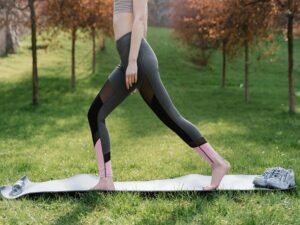An excellent functional workout is a Reverse Lunge. You engage lower-body muscles, which immediately enhances your athletic ability. If you don’t participate in any sports, you’ll at least notice how much better your walking will be. In all honesty, the reverse thrust is one of the few lower-body workouts. It is superior to a forward lunge. The workout tones your leg while putting less strain on your knees than a standard lunge.
What is Reverse Lunge?
It is a leg and balance workout to proper form all the muscles in your leg muscles. Walk backward while maintaining a correct posture and an adjusted upper body to reverse lunges. Stop down until your front leg forms a pivot point. The lunge variety to incorporate into your power training routine is the reverse lunge. It provides you do them with good form.
Tips to Reverse Lunge
They are the following:
- Begin by remaining with your feet hip-width out your knees slightly bent. Your mind and neck should be in a neutral posture. Your shoulders should be directly above your hips. As though cradling an egg beneath your chin, it should remain tucked.
- To establish a sturdy position, spread your weight uniformly. Grab the ground with your toes.
- Grasp the edges of your hips with your palms. Put some strain on your shoulders, hips, and belly, and start each repeat from this location.
- Make a foot backward and extend your hips, knees, and ankles. It is while keeping a neutral vertebra. When your back knee is only a few inches above the ground. It is to lower your hips to the surface.
- Your load should be evenly throughout the front foot. It should be in a neutral position. Straight above your big toe should be your rear knee. Your back hip ought to be higher than your back knee.
- Your legs are at 90 degrees from one another in the lunge. As you come to the bottom of the exercise, your pelvis should be in a relaxed state.
- At the bottom of the motion, stop.
- Hold your chest up as you push your foot into the floor. It is to start the upward drive, then bring yourself up eventually to a static posture. It is with the help of your glutes and quadriceps. Maintain your toes connected and emphasize pushing through your midfoot and ankle.
Difference between Reverse and Forward Lung
Move style:
An advance lunge engages your front leg, whereas a reverse lunge concentrates on your back leg.
Targets for exercise:
Both lunge versions target many of the same lower body core muscles. It is on distinct parts of the body. It is the lunges that highlight the quadriceps on your front foot. Reverse lunges provide a focus on the glutes and thighs.
Degree of confusion:
Compared to forward lunges, reverse lunges often place less stress on your knees. It makes them a lower-body exercise. Before a forward lunge, prepare a backward lunge. Suggest keeping a kettlebell, a set of dumbbells, or resting a barbell on your spine. It is while performing lunges if you want to make the exercise harder.
Benefits of Reverse Lunge
The reverse lunge generally puts your glutes through a little more of a workout than a standard forward lunge. It emphasizes using your quads and increases your productivity. We receive a massage in the glutes. It is to a reverse lunge, and your glutes and quadriceps support you. You’ll undoubtedly experience the heat. Your joints will be under far less stress than the standard lunge. If you have any knee problems, it is ideal.
Some Errors in Reverse Lunges
Anterior knee collapses
You must maintain your front knee in contact with your feet. It is while performing the reverse lunge and your middle toe. There are numerous possible reasons why the front knee may cave inward, which is a typical error.
Hunkering Down
Hunching your upper body ahead as you perform the lunge is another typical error. Instead, when you complete the lunge, maintain your head up, your upper body upright, and your shoulders back. It is you have a firm upper. You will experience a pull on your hips and thighs. Your body moves in the same direction as your eyes. While walking, maintain your head up and look in front.
Side to Side Bending
It can be challenging to balance, a bodyweight lunge, or carry dumbbells in your arms. Your torso can start to swing in different directions. Please be aware that if your front knee extends past your toes. It could create pressure on the knee. The secret is to exert even pressure over the front of your shoe. It is while feeling the workout in your front thighs and glutes.
Techniques for the Reverse Lunge
- At the end of the cycle, the forward thigh should be with the ground.
- Maintain the front foot firmly. The heel is on the ground. It keeps both feet aimed directly ahead.
- It is throughout the exercise. Stand up straight, your back straight, and your poise.
- At the bottom of the round, your back knee should only be a few inches above the surface.
- Inhale as you lunge downward. Fiercely exhale as you raise yourself back up.
Final Words
When done correctly, reverse lunges can increase your cardiovascular fitness. It is while also assists in the development of single-leg stability. A load of heavy dumbbells held at your shoulders can make the reverse lunge an efficient muscle. If you incorporate reverse lunges into your regimen, pay attention to how you balance. It is how upright your stay, and the key lies in it. An excellent workout for the lower body’s muscles is the reverse lunge. You may target your hips, buttocks, and calves and don’t have to perform lunges. We can have them at our residence. You can do your lunge and come back to the position, then swap legs and do it again. It can be in a compact space.

